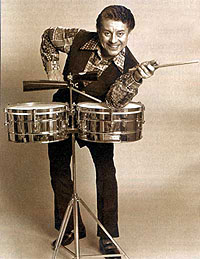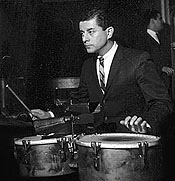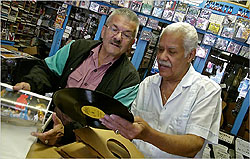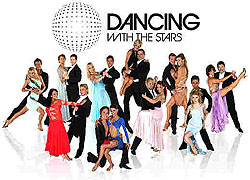 Joe Conzo (Tito Puente - 'Dance Mania')
Joe Conzo (Tito Puente - 'Dance Mania')
'No ser un cayuco, la danza (Don’t be a square, dance!)'
The music of Tito Puente has never gone out of fashion. From the original recordings in the 1950s which started the original Mambo craze, through re-interpretations by Carlos Santana in the 70s, the theme of the film ‘The Mambo Kings’ in the 90s, and now with the resurgence of interest in Latin dancing courtesy of the hit TV show Dancing With The Stars, his music has endured.
Why is it that, in the last 50 years as music styles have changed so radically, Tito Puente’s music continues to appeal? One possible explanation is that he made happy music, and everyone loves happy music. Combine that with sexy, danceable and wonderfully played and you have a recipe for musical success and longevity. There is something magical about Latin percussion; the conga, bongos, timbales, maracas and cowbells that will instantly get your toes tapping and before you know it you are thinking mambo, cha-cha, bolero and rumba.
Tito Puente was the undisputed ‘King of Mambo.’ ‘El Ray’ first hit the bandstand in NYC in 1949 and held sway until his passing in 2000. Tito Puente recorded more than 120 albums, an incredible output by today’s standards. However, his landmark album, the one that put Latin music on the musical map was 1958’s ‘Dance Mania’.

'Dance Mania: Legacy Edition' is now released as a deluxe double CD package. Containing a liner notes essay co-written by Charles L. Granata and Joe Conzo, 'Dance Mania' is coupled with its successor, 1961’s 'Dance Mania - Volume 2,' which, including bonus tracks, is an impressive 45 tracks and over 2 hours of music.
Among the many percussionists who join Tito Puente through the sessions are such Latin music stars as Ray Barretto, Willie Bobo, Mongo Santamaria and Louis Perez.
'Dance Mania' was the biggest selling record of Puente’s career, and just before his death in 2000, the New York Times listed the album as one of the 25 ‘most significant albums of the last century’ – and it was the only Latin album to make the list. I got the chance to chat to Joe Conzo and asked him how he became involved in the package. "Well, I’m considered the world’s foremost authority on the man and his music. The record company wanted to celebrate over 50 years of TP and DM is considered a very important album in the history of Latin music. I provided all the photos and information for the release. Let’s be realistic, they didn’t know the album was considered one of the top albums of the twentieth century. Anything that they have in music involving TP people usually get in touch with me. So that’s basically how I got involved."

Tito Puente released over 120 albums, what made DM so special? "It was an album that, after three years without a vocalist, he came to RCA Victor and he did a dance album. It was the height of the Palladium, in New York 1957, he had just lost Mongo Santamaria and Willie Bobo to Cal Tjader’s band and people were looking for something different."
"At that time you had the big three Puente, Rodriguez and Machito and the music was very competitive, especially with the dancers. This album, in itself, as far as Tito was concerned he said he just did another album. He didn’t think much of it at the time until it started to get all the airplay. He was a consummate musician, he was always experimenting. It gave him a chance to branch out and do other things including blending Latin and jazz together."
With the popularity of Latin music in the late 1950s, (a lot of middle of the road pop performers released Latin-tinged albums) did Tito Puente benefit from this at all? "When people like Perry Como, Lena Horne, and Rosemary Clooney released Latin albums they did it as a commercial venture. Tito had his own style; it was a pure form of the music. At the time those other artists just took advantage of the fashion for Latin music, but it did help publicize Tito’s music, so it wasn’t such a bad thing."

How did you know Tito Puente? "I met Tito in 1959 and I met him again in Japan when I went to Korea, I was in the service. Tito had a good following in Japan. I said ‘Hi’ to him on night in Japan and he recognised my face from the neighbourhood. I grew up with his widow, his older son Ronnie went to school with my sister. It was destined to be. Tito had a major following in the Far East; he opened all the Blue Note clubs in Japan, there is a lot of similarities between Latin, jazz and Japanese music. They have a good taste in music and they love their jazz."
Tito Puente was known for his arrangements – was he classically trained? "He originally wanted to be a movie conductor. He studied the Schillinger System, just like Quincy Jones and Stan Kenton. If you ever get the chance to listen to some of his recordings that have never been available, you can hear Tito arranging for a symphony orchestra. He would take the nucleus of his band; the percussion and maybe one or two trumpets, and put them in the middle of a symphony and the arrangement would be there, to say ‘Oye Como Va’, with a full symphony orchestra."
Is Tito Puente’s music known to a younger generation? "Some of them. You have to explain it to them. Although his music is often heard these days in TV commercials, so some young people may know of his music without necessarily knowing of Tito Puente himself. For example, Nissan used ‘Oye Como Va’, so when I give lectures and people say “who is Tito Puente?” I say “you ever heard the Nissan commercial? Well he wrote it”, and then they know. There’s not really a contemporary Latin scene at the moment because the radio doesn’t play that stuff."

Do you watch Dancing with the Stars and what do you think of the interest in Latin dancing? "My wife loves it. If she’s ever out I have to tape it for her, or I’m in trouble. If Tito were still alive he would have loved it, he liked to see people dancing, especially ballroom dancers. Tito was a dancer, but what you are watching on the TV show is ballroom dancing, so, although you can appreciate the music it’s not the same as the Palladium scene and the dancers they had there. Sadly, there is no film from the Palladium days, which is a big regret, however there are live recordings."
What do you think is the lasting legacy of Tito Puente? "Tito’s legacy is that his music is known the world over, and, as long as I am alive, I’m going to keep pushing his music. The most important thing about him is his legacy; his music is re-born every ten years. He travelled the world; Europe, Japan, The Far East, Hong Kong, Russia, Australia, a lot of places that American musicians never went. He was considered an ambassador for Latin music; he opened the doors for Latin music everywhere."
** Tito Puente – Dance Mania: Legacy Edition (RCA/US Latin/Legacy) is released on all formats on May 26, 2009 **
Interviewed by: Peter 'taB' Walker
www.legacyrecordings.com
Back To Archives

